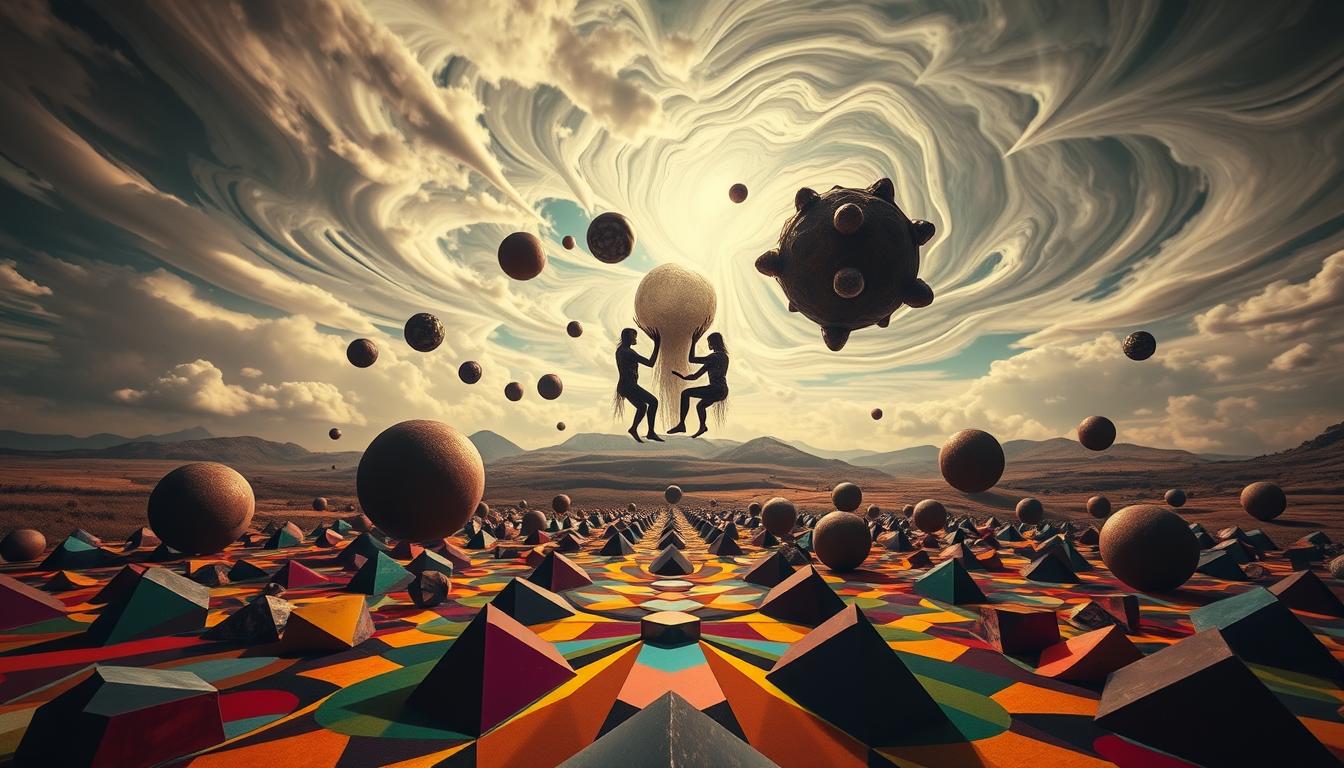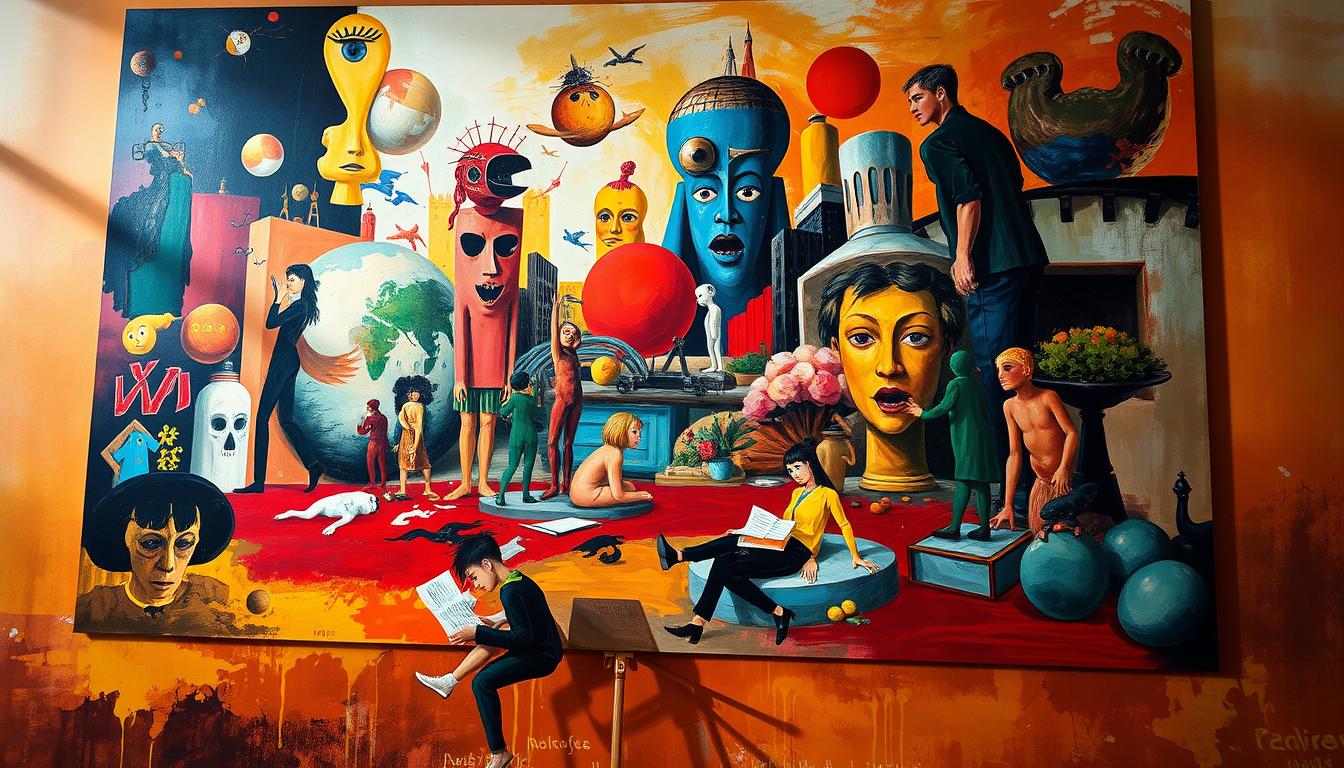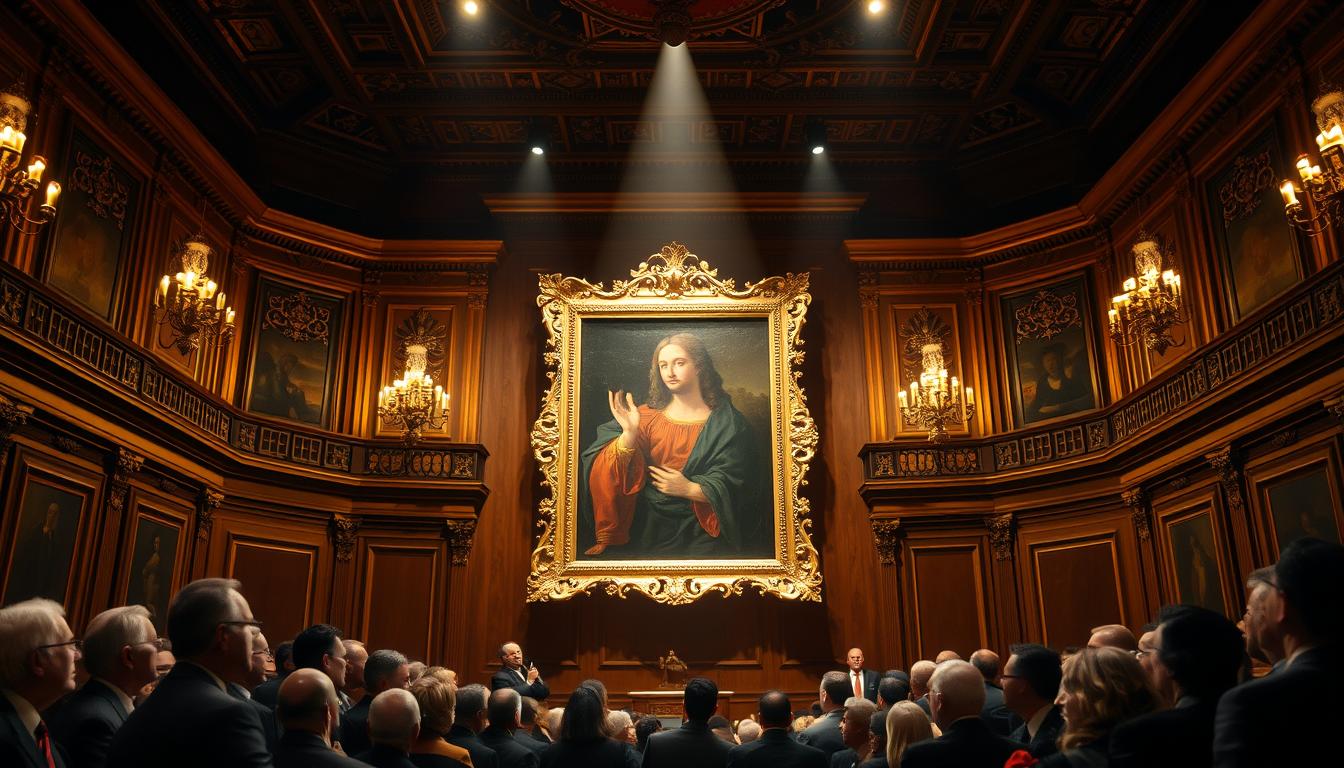
Can a realistic image make the strange feel ordinary and push you to rethink life?
Absurd painting flips familiar reality to raise fresh questions about meaning and truth. Artists use convincing realism so odd combinations sit just close enough to feel real.
Absurdity here is not random noise. It works like a set of creative rules that frees viewers from propaganda, ideology, or ready-made tastes.
In these works, ordinary elements are reassembled into puzzles. Titles and visual hints act as first keys, inviting people to join the search for purpose rather than handing one answer.
Think of the philosopher Albert Camus and the Sisyphus myth: the human drive to find sense in a world that resists tidy explanations. That idea helps explain why many paintings welcome multiple readings.
For a closer look at Michael Cheval’s approach and how these images invite co-authorship from viewers, see this short guide on Michael Cheval and absurd art.
Key Takeaways
- Absurd painting uses realism to present strange juxtapositions that provoke thought.
- It treats absurdity as a tool, not meaningless chaos.
- Titles and clues invite active viewing and personal interpretation.
- The movement connects with real feelings about purpose and existence.
- Influences range from Surrealists to playful literary sources.
Absurd painting in plain terms: where art, life, and meaning collide
Everyday scenes get nudged off course so viewers must rebuild meaning from clues. This style uses realistic detail to stage impossible joins that call attention to how meaning forms in the mind.
Defining absurdity in art: an inverted side of reality
Absurdity here treats the world as a puzzle. Each work offers a clear image that behaves by its own rules. Titles act as the first clue and invite people to step into the search.
From philosophy to painting: Absurdism’s view of meaning and existence
“Art can rebel against a world that refuses final answers while still giving brief solace.”
Camus suggested that seeking ultimate purpose in existence fails, yet creative acts resist that passivity. Artists echo this by making scenes that ask a question rather than hand an explanation.
Key elements and motifs: symbols, puzzles, and playful logic
- Recurring motifs: moons, ladders, glowing spheres.
- Time feels folded; objects swap function.
- Precision rendering + playful logic prompts curiosity and wonder.
| Element | Function | Viewer cue |
|---|---|---|
| Moon or sphere | Symbolic anchor | Title hint |
| Ladder or cloak | Metaphor for passage | Sense of time |
| Sea-as-cape | Role reversal | Invites imagination |
What is absurd painting? Evolution, artists, and styles over time
From page to canvas, creators distilled existential unease into single images that linger.
From literary absurdism to visual art: a past-to-present arc
Absurdism began with philosophers and novelists wrestling with meaning in a world that resists tidy answers. Camus’s essays framed existence as lacking final purpose, and writers turned that tension into language games and paradox.
Painters then borrowed that impulse. Early to mid-20th century artists bent order and beauty so a familiar scene might suddenly behave otherwise. The result: images that hold a question rather than supply closure.

Influences and artists: from Dali and Magritte to Michael Cheval
Salvador Dalí gave meticulous illusion; René Magritte offered witty paradox. Together they set a template where precise technique meets conceptual twist.
Writers such as Lewis Carroll and Edward Lear seeded visual play with word logic. Michael Cheval follows that lineage but draws from imagination rather than dreams. Works like Melody of Rain (2015) use exacting craft to suspend disbelief and invite personal readings.
- Early influences gave painters a way to reorder the world.
- Motifs—moons, ladders, spheres—moved from surprise to structured puzzles.
- Today’s artists blend philosophy, technical skill, and playful inquiry to make works that reward repeated viewing.
How viewers find sense in the senseless: interpreting absurd paintings
Interpretation begins the moment a name meets an image; that pairing sets a detective tone for the mind.
The title as the first clue: naming guides attention
Start with the title. A name like "Fifth Element" primes people to look for elements and roles. That narrow focus makes the search faster and more fun.

Order versus chaos: why the brain enjoys the puzzle
Clear technique and familiar objects give the mind pattern. Small rule breaks—swapped functions or odd juxtapositions—create curiosity.
Research shows pattern rewards the brain while incongruity sparks motivation. The mix explains why viewers linger, even without one final explanation.
Co-authorship and examples: multiple truths from one work
Artists like Michael Cheval invite co-authorship. Your reading is an honest attempt, not a mistake.
Take "Fifth Element": glowing spheres, a sea cape, and the moon suggest a hidden function that ties the scene together. That line of sense is plausible but not exclusive.
- Scan for repeated elements.
- Track objects that change function.
- Use the title to test small hypotheses.
"Meaning can emerge, shift, and sometimes recede—enjoy the search."
Conclusion
Ultimately, the best of these images turns technique into an open door for feeling and thought. In that space, art meets life and invites a personal reply rather than a single answer.
Camus taught that creation cannot erase meaninglessness, yet it can state a clear stance. One fact remains: artists build a world where questions last and reactions, even negative, count.
These paintings ask for participation. Try titles as clues, slow down, test a reading, and notice which details shift your view—this practical step will change your reality of the work.
For more on related themes, see this short guide to the absurd, the bizarre and the. Smile, lean in, and let curiosity lead—that signals you are in the right place to explore new connections.
Enhance Your Space with Unique Modern Masterpieces
Are you inspired by the innovative mediums and conceptual depth highlighted in our exploration of contemporary art? You’re not alone! Today’s art enthusiasts are seeking cultural relevance and emotional connections in their artwork. However, finding pieces that resonate with modern themes and fit your unique style can be a challenge. That’s where we come in!
At Rossetti Art, we specialize in canvas prints, original paintings, and modern sculptures that celebrate the spirit of now. Each piece created by Chiara Rossetti brings a personal touch that connects deeply with current social narratives—just like the modern masterpieces discussed in the article. Don’t miss out on the chance to elevate your home decor with breathtaking artwork that speaks to your values and aesthetic. Explore our collection today and find your perfect piece! Act now, and transform your space into a gallery of inspiration!
FAQ
What does absurd painting mean in art?
Absurd painting explores surreal combinations and playful logic that unsettle everyday expectations. It mixes familiar objects, odd juxtapositions, and symbolic puzzles to prompt fresh questions about life, meaning, and perception.
How does absurdism in philosophy influence visual work?
Philosophers like Albert Camus described a tension between the search for purpose and an indifferent universe. Artists translate that tension into images that refuse tidy answers, inviting viewers to sit with mystery rather than resolve it.
Which motifs commonly appear in these images?
Look for recurring symbols such as floating objects, mismatched scales, and playful logic where cause and effect swap places. Artists use these elements to test the limits of reason and spark imaginative responses.
How did literary absurdism lead to visual art movements?
Mid-20th-century writers opened discussions about meaninglessness and human resilience. Painters and illustrators adapted those themes visually, using composition and metaphor to ask the same existential questions without words.
Who are notable artists linked to this approach?
Surrealists like Salvador Dalí and René Magritte laid groundwork with dreamlike imagery. Contemporary makers such as Michael Cheval carry the thread forward, blending craft with inventive, sometimes humorous twists.
Can titles change how we read an image?
Yes. A title can nudge interpretation, acting as a guidepost that reframes odd details into a coherent idea or ironic counterpoint. It’s often the first clue that leads viewers into the painting’s logic.
How do viewers make sense of apparent chaos?
The brain seeks patterns, so viewers pair familiar cues with strange contexts to build meaning. That interplay of order and disorder produces pleasure and new insight rather than a single fixed answer.
Are viewers considered co-creators of meaning?
Absolutely. Most practitioners welcome multiple readings. Each person brings memories and associations, which transform the work into a living dialogue between artist and audience.
Can you give a practical example of interpretation?
Imagine a moon held like a tool in a figure’s hand. Some might read it as a joke about utility, others as a comment on misplaced power. Both responses reveal personal priorities and emotional associations.
Does this art imply life has no purpose?
Not necessarily. Rather than claiming nihilism, many works highlight tension and encourage reflection. They open space for wonder, humor, and critical thought about what we take for granted.






Leave a comment
This site is protected by hCaptcha and the hCaptcha Privacy Policy and Terms of Service apply.